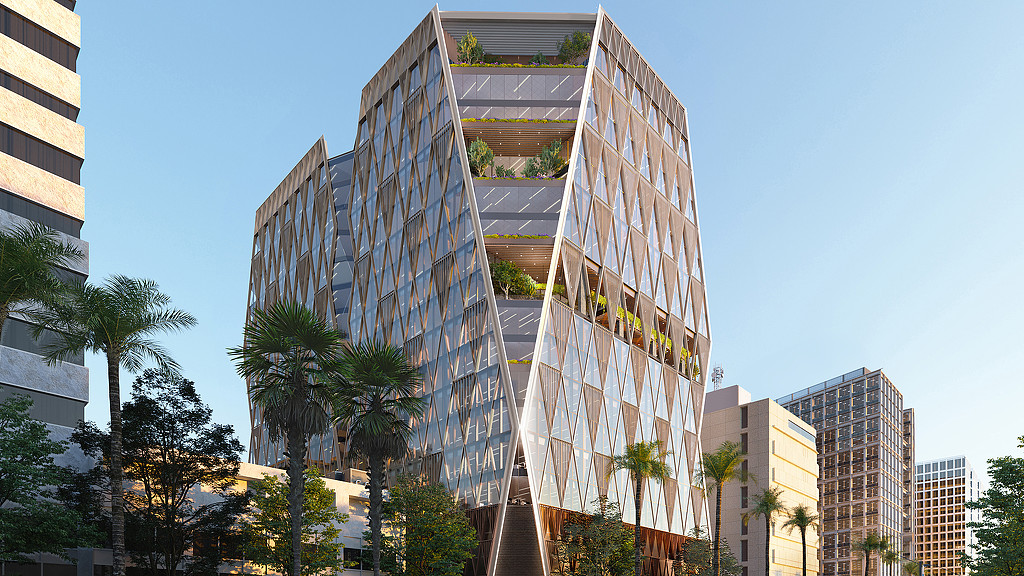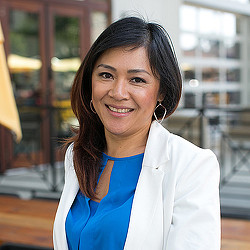Almaden Tower: Quickly Delivering an Innovative Office Building to Market
March 02, 2021 | By Ton Men Banh, Sean McFeely, and Christine Laing
As we emerge from the COVID-19 crisis, speed to market and innovative design are critical for delivering new office buildings that respond to tenants’ needs. With quality outdoor experiences, ample collaboration spaces, and expansive views of Silicon Valley, Gensler’s design for 50 Almaden Boulevard Tower, a new high-rise office building in downtown San Jose, California, delivers a highly sought-after, valuable tenant experience. By working together with the city, Gensler obtained approvals in record time — proving that innovative and tenant-responsive buildings can be quickly delivered without sacrificing design quality.
San Jose is the largest urban center in Silicon Valley with many unique attributes that have sustained a high interest in development opportunities. The city established the 2019 San Jose Design Guidelines and Standards to promote design excellence, sustainable urbanism, and sense of place for the great benefit of the community and region.
The city of San Jose approved Gensler’s design for the 50 Almaden Boulevard Tower under the Downtown Design Guidelines in December 2020. Our goals included a timely approval, responsive tenant environment, and an impactful sustainability strategy to address climate change, but it all hinged on the collaborative journey we embarked upon to align stakeholder goals with the city’s aspirations.
Based on these insights, here are a few considerations to quickly deliver innovative office building designs to market:
1. Align project goals and regulations.The time to complete the entitlement process is often long and a source of frustration for developers who are trying to deliver timely projects to the market. Gensler was asked to obtain approvals in less than a year. From the start, the design team needed to seek alignment between the project design goals and city regulations. It was immediately apparent that we were going to have to mediate conflict between competing goals and that we needed to facilitate dialogue around our shared purpose with a clear story of the synergy between the design proposals and the spirit of the guidelines.
2. Engage stakeholders early in the process.The team met with the city early in the design process to review the design progress and discuss concerns. This approach to early engagement and feedback led to the co-creation of innovative design strategies and helped limit the formal architectural review process to two rounds. As a result, the project went from start to approval in 11 months, with the formal site development permit approval occurring within five months.
Our approach to incorporating the city’s guidelines had to work for both the city and project sponsors. By engaging all stakeholders early, and with a shared understanding of design priorities, we were able to manage inevitable conflict resolution, iterate quickly through potential options, and propose innovative solutions to specific areas for the maximum benefit of the project for all stakeholders while adhering the guidelines and standards.
3. When it comes to design guidelines, think outside the box.Rather than prescriptively following the Downtown Design Guidelines, we responded to each requirement in an unanticipated, and ultimately beneficial way:
- Skyline Level Massing. This requirement states that skyline level façades are to have changes in massing to reduce the apparent building bulk. A typical response to this guideline would be to insert a vertical “cut” into the building to create the appearance of two slender, less massive buildings. This requirement seeks to preserve views and daylight for pedestrians and occupants of other buildings, but for 50 Almaden Boulevard Tower, this approach would have impacted the building’s floor area and would have awkwardly placed the cut on the site.
Instead of following a prescriptive course for this guideline, Gensler interpreted the cut as chamfering the building corners to open the tenant views to the unobstructed corridors between the neighboring buildings at the project corners. Tapering the chamfers as the tower rises further increased the view potential of the valuable upper floors and resulted in an elegant solution to break up the large tower massing to meet the design guideline requirements, while providing unique, quality interior spaces.
Additionally, we introduced horizontal slices through the building to create outdoor terraces on the middle upper floors. The synergy between the interior design drivers and the exterior massing resulted in a compelling design inside and out, while creatively adhering to the spirit of the guideline for the building exterior.
- Distinctive Building Top. A standard for a distinctive building top that is distinguishable from the rest of the façade influenced our processes as we studied the connection of the interior experience and the translation of the inside to the outside onto the building’s façade. We took an innovative approach to meeting this guideline by coupling it with sustainability goals, which are fundamental to our firm, as well as project stakeholders and tenants in Silicon Valley.
The façade is a critical element in a tower’s sustainability strategy. For 50 Almaden Boulevard Tower, a high-performance façade responds to the climate using a series of large-scale triangular louver panels distributed strategically across the four main elevations. The façade design uses analytical performance data, including solar radiation and sun angles, to help provide shade, prevent glare, and filter daylight. The direction and density of the louvers significantly reduce the solar heat gain and allowed us to utilize more transparent glazing for increased natural light to create an optimal interior work environment.
Additionally, the triangular modulation of this façade system allowed for flexibility in sizing and location of the modules and louvers panels, which was expressed at the roof level. This unique approach satisfied the city’s design standard for a distinctive building top.
- Podium Level Articulation. This standard requires that “Podium level building massing facing public space wider than 100 feet into visibly smaller masses no wider than 80 feet using projections, recesses, materials, shadow relief and other architectural elements.” We addressed this standard by once again using the chamfered corners, which were initially conceived to maximize views for the tenants, to address this articulation requirement.
By working together with the city to understand synergies and priorities between project goals and city design standards, we delivered a quality and impactful design, accelerated the process, met this ambitious schedule, and created a valuable tenant experience.
For media inquiries, email .


